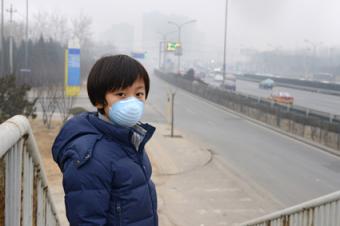
For years, it's been understood that the effects of air pollution in humans are seriously detrimental to health. Increasingly, as the measurements are refined, the projections grow more dire. Air pollution is a problem for global warming, which is bad for everyone in the long term, but is also disastrous in observable ways now.
Pollutants' Effects on Health
In the 1950s and 1960s, the air quality in Los Angeles was some of the worst in existence, according to Sarah Gardner at Marketplace. As far back as the 1950s, physicians in California started discussing the ways in which smog could be influencing the development of heart problems and lung cancer, Gardner notes. Since then, research has shown that air pollution offenders, both small and large, have effects on human health.
Effects of Smaller Pollutants
According to WebMD, the smaller effects of air pollutants like volatile organic compounds can include headaches and irritated eyes and throats. Eyes may be itchy and red, requiring saline drops to feel better, and there may be some coughing. Someone who is exercising and thus breathing more deeply may have a stronger reaction, along with anyone with an already compromised immune system.
Effects of Larger Pollutants
According to the Environmental Protection Agency (EPA), ground-level smog is one of the most influential air pollutants in existence, and even six hours worth of comparatively low ozone exposure can lower a person's lung function, often with associated nausea, chest pain, pulmonary congestion, and coughing. The EPA also indicates the following pollutants are problematic:
- Nitrogen dioxide - Nitrogen dioxide can reduce the body's ability to fight respiratory infections and cause lung irritation.
- Sulfur dioxide - Sulfur dioxide is linked to weakened pulmonary defenses, breathing problems, worsened symptoms in people that have cardiovascular disease, and respiratory diseases themselves.
- Carbon monoxide - Carbon monoxide concentrations in the air have decreased overall, but persistent high levels of carbon monoxide can lead to various neurological and visual impairments.
- Lead - The areas near battery plants and smelters may have relatively high levels of lead in the air, and the EPA links lead to kidney disease, neurological impairments, anemia, reproductive disorders, osteoporosis, and high blood pressure.
Children and Air Pollution
Children and members of other sensitive populations are almost always going to be more vulnerable to problems like air pollution. According to WebMD, the fact that kids proportionately take in larger quantities of air compared to adults makes them more vulnerable to air pollution. Children also tend to play outdoors more, engaging in sporting activities that speed up their breathing even more. Their lungs are also still developing and thus more vulnerable. Parents have to be especially vigilant about maintaining high-quality air in the house and noting days when the outside air is particularly bad.
Asthma and Air Pollution
According to the National Resources Defense Council (NRDC), sulfur dioxide, particulate matter, nitrogen oxide, and ground level ozone can all trigger asthma. The NRDC estimates that 131 million Americans have to breathe low-quality air on a regular basis. The NRDC traces many of these pollutants to power plants, cars, and factories.
Thomas H. Maugh II at the Los Angeles Times indicates that cases of asthma are becoming steadily more common in the United States. Health costs are spiraling as a result. Maugh says that in 2007, the medical costs associated with asthma reached 56 billion dollars. The NRDC estimates that 30 percent of the incidences of asthma in children can be traced to environmental exposures, and air pollution may cause healthy people to get asthma. Maugh also indicates that there are more incidences of asthma among children than incidences of asthma among adults.
Air Pollution Today
It can feel like a losing battle to try to improve air quality.
Global Pollution Affects the U.S.
The bad air in China blows over the ocean and affects people in America. A study from the Proceedings of the National Academy of Sciences of the United States of America suggests that Chinese air pollution adds to the sulfate pollution in the Western region of the United States. My Health Beijing indicates that some cities in China have such bad air, people wear masks when on the street and pollution masks are widely available at convenience stores. Improving air quality will take worldwide effort and vigilance.
How to Combat the Pollution Problem
There are many things the individual can do to combat the problem. One of the biggest is choosing to take public transportation. Anything that reduces car emissions can help. Walking, riding a bike or carpooling all help. When driving, people can try to use gas-saving tips and when it's time for a new car, they can choose one with better mileage, such as a hybrid. At home, people can also avoid using a wood fireplace or coal burning stove. Alternative sources of heat are better for the environment.
Air Pollution Progress
The NRDC indicates that the United States has made progress against air pollution since the mid-twentieth century, but millions of American citizens are still being threatened by air pollution. The NRDC recommends more rigorous national air quality standards for the worst air pollutants as a short-term means of addressing the problems. However, the NRDC ultimately stresses the need to end society's reliance on fossil fuels.







